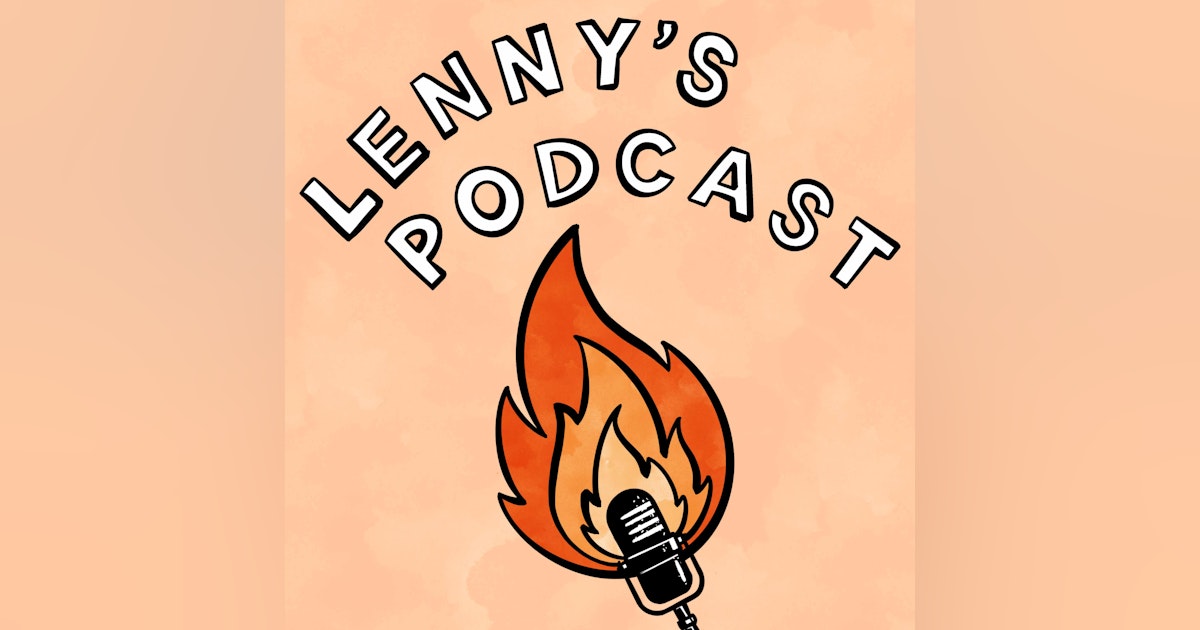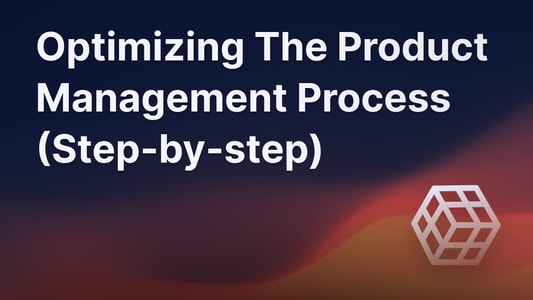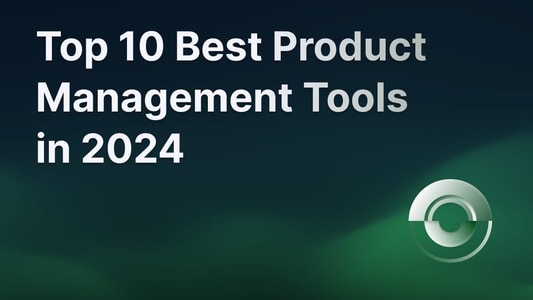Blog Product ManagementProduct-Led Growth: Overview & Real-world examples
Product-Led Growth: Overview & Real-world examples
Find out why Product-Led Growth is taking over the SaaS world and the strategy behind the success of companies like Notion and Grammarly. We'll dive into what PLG is, how it's changing the SaaS industry, and how you can use it - with real examples and tips.

Product-led growth is a strategy where the product itself becomes the main driver of growth.
It has been taking over the SaaS space with companies like Notion and Grammarly being perhaps the best examples.
Compared to sales-led strategies, product-led companies let you sign up for free and test everything out in just a few minutes, without having to book a 30-minute meeting with a sales team.
However, why is it better than the other strategies, and how exactly does it work?
That's what we'll cover in detail - by the end of this blog, you'll have a comprehensive overview of what product-led growth actually is, how you could implement it, and get an overview of the most successful examples to learn from.
So let's dive right into it.
What is product-led growth (PLG)?
Product-led growth (PLG) is a business strategy focused on using your product as the primary driver of acquisition, conversion, and expansion.
At its core, PLG focuses on creating a product that offers an amazing user experience - basically making the product so intuitive that users naturally want to use it every day and share it with others.
This approach is on the other end of traditional growth strategies that rely heavily on sales and marketing teams to push the product.
In PLG the users find the company through word of mouth or other channels and then start using it in a self-serve model.
In short, PLG places the product at the heart of the growth process, using it as the main vehicle to drive business outcomes.
This method not only helps in scaling the product faster but also in building a loyal user base that's more likely to stick around because their initial engagement was driven by genuine interest and value, rather than aggressive sales tactics.
Why is product-led growth taking over the SaaS industry?
There are many reasons why product-led growth is becoming largely the only strategy for certain industries.
Here's a quick rundown:
1. Competition is becoming stronger
Every year the cost of building quality software is rapidly dropping with advancements in AI and the popularity of open source.
However, this introduces a problem that was not present 10 years ago:
- Acquiring new customers is harder and more expensive - When everyone is competing for the same channels to grow, the cost of reaching potential customers and acquiring them skyrockets.
- The cost of software is dropping rapidly - It's common knowledge that when the supply increases more than the demand, the price will drop. The same is happening in the SaaS industry.
Therefore, growth tactics like SEO are no longer that effective, and running ads on platforms like Google/Meta has become much more expensive.
Since there are so many more options on the market, consumers are also much more picky to switch between different products when something isn't a good fit - increasing churn rates.
Product-led growth simply drives customer acquisition costs to a level that is not replicable by other strategies and by putting your product first, you make sure no one considers switching to a similar product.
2. User expectations have evolved
Today's consumers have higher expectations than ever before.
They seek immediate value and gratification without the hassle of traditional sales processes. The modern user prefers to explore and understand a product at their own pace, rather than being guided (or pressured) by sales pitches.
This shift in user behavior aligns perfectly with the PLG model, which allows users to experience the product directly, creating a natural and organic relationship with it.
By meeting users' expectations, PLG strategies are more effective in capturing and retaining the attention of today's savvy consumers.
3. Viral growth is more achievable than ever
In a world dominated by social media and digital networks, the potential for products to go viral has become a critical factor in achieving exponential growth.
PLG leverages this by integrating shareability and network effects directly into the product experience.
When users love a product, they're likely to share it with their network, leading to organic growth that can outpace traditional marketing efforts.
Notion and Grammarly, for instance, have benefited immensely from users sharing their positive experiences and content created with these tools.
By focusing on creating a product that users love and want to share, companies employing a PLG strategy tap into the natural growth mechanisms.
With these factors in play, it's clear why PLG is not just an alternative strategy but increasingly the preferred path to success in the SaaS space.
How does product-led growth work?
Here's a playbook for product-led growth:
- Lower the Barrier of Entry: Start by making the product approachable with freemium or free trial models. This step is crucial for attracting users by offering them a risk-free way to experience the product.
- Make your product amazing: The goal is to make users fall in love with your product. This involves creating an exceptional product and prioritizing the user experience above all. A great user experience is key to turning first-time users into long-term fans.
- Encourage Sharing and Referrals: Implement built-in sharing features, and incentives for referrals, or leverage naturally occurring network effects. These strategies help with virality, making it easier for satisfied users to spread the word about your product.
- Build a Community: Encourage all users to join a community around your product. Engaged users who feel part of a community are more likely to stick with the product and recommend it to others.
- Leverage word of mouth for B2B Sales: As your product gains traction among individual users, it can also start being adopted by larger organizations. Employees who use and love your product for personal reasons can become champions for adopting it within their companies, creating B2B sales without traditional sales efforts.
By following these steps, a PLG strategy leverages the product's own strengths and user satisfaction to drive growth, reducing the reliance on traditional sales and marketing methods.
Benefits of product-led growth?
Lower CAC (Customer acquisition costs)
One big reason PLG is outshining other strategies is its efficiency in cutting down costs.
When your product directly pulls in customers, you spend less money on marketing and sales teams. This approach drives down the customer acquisition cost significantly, making PLG not just effective but also incredibly efficient.
Viral growth engines
Happy users are the best promoters.
PLG encourages users to share their positive experiences, turning them into advocates for the product.
This organic spread of the products created through word of mouth or social sharing amplifies reach without spending money on expensive advertising campaigns.
Faster Sales Cycles
By eliminating the need for lengthy sales processes and demos, PLG allows users to directly engage with the product. This direct engagement can significantly shorten the sales cycle, as users can quickly move from discovery to decision-making based on their experience with the product.
Higher Product Quality
A focus on PLG necessitates a continuous emphasis on improving the product based on user feedback and usage data. This leads to a higher quality product that is closely aligned with user needs and preferences, further driving user satisfaction and retention.
Increased User Retention
Users acquired through PLG tend to have a higher retention rate. This is because their initial engagement is based on the actual value they derive from using the product, rather than being persuaded by sales or marketing efforts. A better user experience leads to higher satisfaction, which in turn reduces churn rates.
By focusing on creating a product that sells itself, companies can lower acquisition costs, foster organic advocacy, and adapt quickly to user feedback. This approach not only accelerates growth but also builds a loyal user base, making PLG a powerful engine for long-term success in the SaaS space.
Best product-led growth examples
Here are the best product-led growth case studies to take inspiration from:
1. Linear.app

Linear has quickly become a favorite tool for software teams looking to streamline their project and issue tracking.
They have scaled to tens of thousands of companies while having spent less than $ 20,000 on marketing expenses. Almost all their efforts have been poured into the product to make it head and shoulders above anything else.
Their attention to detail and craft encourages users to share it with others and try it out on their own.
2. Notion

Notion is another prime example of product-led growth done right.
It serves as an all-in-one workspace where users can write, plan, collaborate, and organize - essentially replacing multiple tools with one.
Notion’s freemium model allows users to experience the product's value before committing financially, which lowers the barrier to entry.
Its flexible platform caters to a wide range of use cases, from personal note-taking to comprehensive team collaboration, making it a tool that users eagerly share with others. The ease of sharing and the inherently collaborative nature of the product have fueled its viral growth.
3. Slack

Slack transformed the way teams communicate, growing primarily through PLG.
It started as an internal tool before becoming widely available and eventually spreading like wildfire across organizations of all sizes.
Slack’s success can be attributed to its user-friendly design, which reduces email clutter and streamlines communication.
By focusing on the user experience and integrating seamlessly with a lot of other tools, Slack naturally encouraged users to invite their teammates, leading to organic growth within organizations.
The product’s value became immediately apparent to new users, creating rapid adoption.
4. Figma

Figma revolutionized the design world by introducing a cloud-based interface design tool that enables real-time collaboration.
Its product-led strategy focused on making design accessible to everyone, from individual freelancers to large teams.
The ability for users to start designing for free, coupled with the collaborative features built into the product, skyrocketed word-of-mouth and social sharing.
Figma became a tool that not only attracted individual users but also quickly found its way into the toolkit of design teams, driven by its ease of use and the collaborative possibilities it opened up.
Each of these examples highlights the core principles of product-led growth: creating a valuable, user-centric product that encourages adoption, retention, and sharing.
Learning more about product-led growth
There are loads of resources to master the product-led growth strategy.
Here are some of the best resources to date that we have found and are fans of:
1. Lenny's podcast

Lenny has an exceptional podcast with weekly appearances of world-class product leaders from product-led companies like Linear, DropBox, and OpenAI, which helps you really get a deep understanding of the topic.
It's a great starting point to get actionable advice for what it takes to build a stand-out PLG company and find out about the inner tips of the industry.
Check it out from here.
2. The Linear blog

Linear is one of the best examples of product-led growth done right in a competitive industry.
They take a very opinionated approach to their style of product building and have great write-ups in their blog about how they plan for work, think about feature development, and prioritize customer requests.
Check it out from here.
3. Read the fundamental books
Books are another great way to deepen your understanding of the topic.
Diving into books is a fantastic way to deepen your knowledge of product-led growth. Titles such as "Product-Led Growth: How to Build a Product That Sells Itself" by Wes Bush and "Hooked: How to Build Habit-Forming Products" by Nir Eyal are must-reads. Plus, these top product management books.
These books offer invaluable insights into the mechanics of PLG and how to design products that not only attract users but also turn them into advocates. They provide a solid foundation for understanding the principles behind successful product-led companies.
4. Communities
The best way to get great at a topic is to surround yourself with other people and experts who are on the same path.
Online platforms such as the Product-Led Alliance, LinkedIn groups focused on PLG, and specific PLG Slack channels offer vibrant spaces to connect with PLG experts and enthusiasts.
These communities are perfect for exchanging ideas, seeking advice, and staying abreast of the latest trends and strategies in product-led growth.
Engaging with others on the same journey enables you to learn from their experiences and share your own, fostering a collaborative environment for growth.
FAQ: Product-Led Growth (PLG)
1. What is product-led growth?
Product-led growth is a strategy where the product itself is the main driver of customer acquisition, conversion, and expansion. It focuses on creating a product with a great user experience, making it intuitive for users to use, share, and advocate for.
2. How is PLG different from traditional growth strategies?
Unlike traditional strategies that rely heavily on sales and marketing teams to drive growth, PLG allows the product to do the heavy lifting. Users can sign up, try the product, and see its value without the need for sales meetings or pitches.
3. Why is PLG becoming popular in the SaaS industry?
PLG is gaining traction because it aligns with modern consumer preferences for trying products before buying, enables viral growth through sharing, and reduces customer acquisition costs. Additionally, as software becomes more competitive and customer expectations evolve, PLG offers a more efficient and user-friendly path to growth.
4. How does PLG work?
PLG works by:
- Lowering the barrier of entry with freemium or free trial models.
- Prioritizing an amazing user experience to make users fall in love with the product.
- Encouraging sharing and referrals to leverage virality.
- Building a community around the product.
- Leveraging word-of-mouth for B2B sales as users advocate for the product within their organizations.
5. What are the benefits of PLG?
The benefits include lower customer acquisition costs, viral growth engines, faster sales cycles, higher product quality, and increased user retention. PLG strategies create products that sell themselves, fostering organic advocacy and reducing reliance on traditional marketing and sales.
The simple feedback tool with feature voting for your customer feedback. Built-in the 🇪🇺.
© 2024 Featurebase. All rights reserved.



